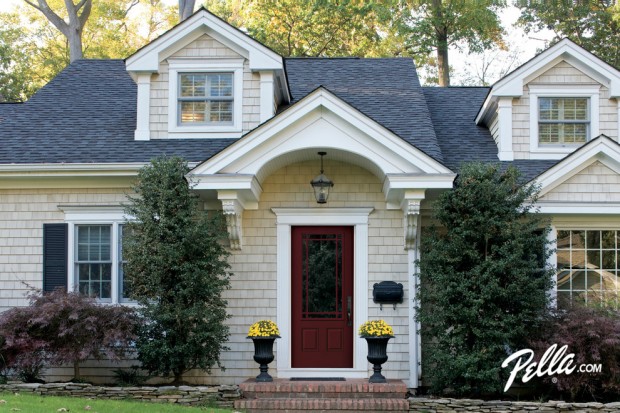Your front entry is what connects the interior of your home with the yard, and the street to that matter. When choosing the right front door for your house, you need to consider several features like material, construction, and lock type. Every option has its strengths and weaknesses, including the price. Your requirements and home style will eventually decide which setting is best for you.
Wooden door
Wood is easy to work with, so these doors are mostly used in situations when an owner requires customized design that will match the rest of the house. There are dozens of options available, from the choice of wood to side lights, stained glass, and so on. Wood is perfect for decorative front doors because it allows many modifications and upgrades. However, a downside of wooden doors is that they can wrap over time, which can lead to cracking or reduced air-sealing properties.
Beach Style Entry by Greer Home Builders Gabriel Builders Inc.
Doors with a hollow core are cheaper, but they should be left for indoor use, between the rooms. Solid doors, on the other hand are costlier but incomparably stronger than hollow core ones, which may be filled only with cardboard or polystyrene. The most affordable material is pine, but if you want to go with a wooden door, stretch a bit more and buy hardwood.
Fiberglass Door
Much more resistant to elements than wooden doors, they can even be stained to mimic the traditional look of their grained counterpart. These doors are made of fiberglass panels with an insulated core in between, so they provide better thermal insulation. Although fiberglass doors can be more expensive than an average wooden door, its durability and better air-sealing capabilities make up for the price.
Contemporary Entry by Other Metro Windows Pella Windows and Doors
Steel Door
Similarly to fiberglass doors, they have insulating foam between the steel panels, and offer the greatest degree of security. Their price range comes halfway between the wooden and fiberglass doors, while their main problem is that dents are hard, or even impossible to repair. To provide better air tightness, these doors can be equipped with flexible PVC gaskets that form a tight seal when the door is closed. Alternatively, magnetic seals like the ones on refrigerator doors are used for increased energy efficiency.
Modern Entry by San Jose General Contractors Chris Donatelli Builders
Energy Efficiency
When talking about energy efficiency, it is typically understood that fiberglass and steel doors have more insulating value than wooden doors. Energy Star-certified models have tighter-fitting frames, insulated cores and double glazing, for doors (and windows) with glass panels. However, spending a fortune on such a door won’t cut your energy bill significantly. It is more important to seal the space around the door, as more heat escapes through air leaks than through conduction.
Contemporary Entry by Kelowna General Contractors Wilson & Company Ltd
Safety
With all the burglaries and theft reports in the news, investing in a secure front door, as well as windows is more reasonable than purchasing a Smith & Wesson. As a start you need to make sure that your new door comes with a high rated lock. In a recent conversation with a seasoned Randwick-based locksmith, it was brought to my attention that even an ANSI Grade 1 or Grade 2 deadbolt is not as burglar-proof as it seems. Most burglars won’t waste time with picking the lock, so the only solution is to fortify the whole doorway.
Contemporary Entry by Melbourne Interior Designers & Decorators White Chalk Interiors
There is no universal best-buy when it comes to front door. If you want an option that will last for decades, fiberglass is the way to go. On the other hand, no one can argue that wood isn’t a prime material for a classy look.

